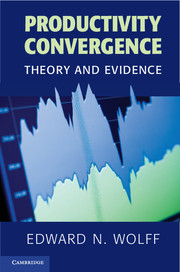Book contents
- Frontmatter
- Contents
- Acknowledgments
- 1 Introduction
- 2 An Overview of Modern Growth Theory
- 3 The Measurement and Estimation of Productivity Growth
- 4 Long-Term Record among the Advanced Industrial Countries
- 5 Postwar Record on Productivity Performance on the Aggregate Level among the Advanced Industrial Countries
- 6 Further Details on the Role of Education and Technology in the Productivity Performance among the Advanced Industrial Countries
- 7 Productivity Performance on the Industry Level among the Advanced Industrial Countries
- 8 The Productivity Slowdown
- 9 Postwar Economic Performance among Countries of the World
- 10 Recapitulation and Future Prospects for Growth
- Bibliography
- Index
7 - Productivity Performance on the Industry Level among the Advanced Industrial Countries
Published online by Cambridge University Press: 05 June 2014
- Frontmatter
- Contents
- Acknowledgments
- 1 Introduction
- 2 An Overview of Modern Growth Theory
- 3 The Measurement and Estimation of Productivity Growth
- 4 Long-Term Record among the Advanced Industrial Countries
- 5 Postwar Record on Productivity Performance on the Aggregate Level among the Advanced Industrial Countries
- 6 Further Details on the Role of Education and Technology in the Productivity Performance among the Advanced Industrial Countries
- 7 Productivity Performance on the Industry Level among the Advanced Industrial Countries
- 8 The Productivity Slowdown
- 9 Postwar Economic Performance among Countries of the World
- 10 Recapitulation and Future Prospects for Growth
- Bibliography
- Index
Summary
Sectoral Level Performance and Comparative Advantage
Chapter 5 established that the aggregate productivity levels of advanced economies converged on the leader, the United States, from about 1950 through 1980. The question remained, however, What was the source of this aggregate convergence? In Section 7.2 we examine the extent to which labor productivity at the industry level converged among OECD economies. We also examine the role of changes in employment mix. In Section 7.3 we consider the role of technological gains and capital formation in labor productivity growth. Section 7.4 surveys the more recent literature on this subject, including Bernard and Jones (1996a, 1996b), among others. Concluding remarks are provided in Section 7.5.
Some industries produce more value added per worker than others, owing to the use of large amounts of capital or skilled labor or of advanced technology. It is possible for countries to have the same labor productivity at the industry level but nevertheless to have different levels of aggregate productivity because one economy’s employment mix is shifted toward the high value– added sectors. One of the leading models of international trade, the Heckscher-Ohlin model, predicts that this will be the case among fairly similar countries, such as those in the OECD. Thus aggregate convergence can result from labor productivity converging at the industry level and/or from employment mixes becoming more similar.
- Type
- Chapter
- Information
- Productivity ConvergenceTheory and Evidence, pp. 269 - 312Publisher: Cambridge University PressPrint publication year: 2013



